Best Cat Food for Kidney Disease : Top 10 Commercial Options in 2025
Quick Guide
- What is the Best Cat Food for Kidney Disease?
- What Are the Signs of Kidney Disease in Cats?
- Understanding the Causes and Treatment Options
- Dietary Recommendations for Cats with Kidney Disease
- The Top 10 Best Cat Foods for Kidney Disease
- Smalls Ground Bird Fresh Cat Food Delivery
- Weruva Cats in the Kitchen Cuties Variety Pack Grain-Free Canned Food
- Hill’s Prescription Diet k/d Kidney Care Canned Cat Food
- Blue Buffalo Natural Veterinary Diet K+M Kidney + Mobility Support Canned Food
- Dave’s Pet Food Restricted Diet Protein & Phosphorus Chicken Formula
- Wysong Optimal Geriatryx Food
- 4 More Top-Rated Cat Foods for Kidney Disease
- Frequently Asked Questions
- Kidney Disease Cat Food – RECAP
Many cats show little interest in water – unless it’s knocking over a glass of it all over your keyboard.
When your cat suddenly starts to drink more water, you might be glad. What you may not realize, however, is that this can be a sign of a serious developing health problem – kidney disease.
Changes in thirst and urination are common indications of kidney disease in cats, and they are signs that should not be ignored. Left untreated, kidney disease can become chronic and may affect everything from your cat’s coat condition to his longevity. Do yourself and your cat a favor by having him checked out at the first indication of a potential health problem.
Talking to your veterinarian to obtain an accurate diagnosis is always the first step in treating a condition like kidney disease. From there, however, you can make modifications to your cat’s diet to reverse the symptoms and to support his health and recovery.
In this article, we’ll explore the topic of kidney disease in depth to help you understand the signs as well as the causes, diagnosis process, and treatment options. You’ll also learn how to shop for kidney support cat food, and you’ll find our top 10 picks for the best cat food for kidney disease.
What is the Best Cat Food for Kidney Disease?
- Smalls Human-Grade Ground Bird Fresh Cat Food – The Healthiest
- Weruva Cats in the Kitchen Cuties Variety Pack Grain-Free
- Hill’s Prescription Diet k/d Kidney Care Canned Cat Food
- Blue Buffalo Natural Veterinary Diet K+M Kidney + Mobility
- Dave’s Pet Food Restricted Diet Protein & Phosphorus Chicken
- Wysong Optimal Geriatryx Food
- Blue Buffalo Natural Veterinary Diet K+M Kidney + Mobility
- American Journey Minced Chicken & Salmon Recipe Canned – Most Affordable
What Are the Signs of Kidney Disease in Cats?
Your cat’s kidneys play an important role in his overall health and wellness. Primarily, it is their job to eliminate excess protein and protein wastes from the bloodstream and to produce urine. The kidneys also play a role in balancing the body’s water, salts, and acids.
When your cat’s kidneys stop functioning properly, it can lead to a variety of health problems including acute kidney disease and chronic kidney disease.
Acute kidney disease is the result of an abrupt (and often severe) injury to the kidneys. When this happens, your cat will become very sick all of a sudden and may stop producing urine entirely. Though this may not sound like a major issue, it is life-threatening if not promptly treated. Chronic kidney disease occurs when the cat’s level of kidney function declines slowly over time. This can happen over the course of months or years, causing mild signs of illness that worsen over time.
Because kidney disease can be very dangerous to your cat’s health, it is important that you learn the signs so you can identify it early and seek treatment.
Some of the most common signs of kidney disease in cats include the following:
- Increased thirst
- More frequent urination
- Subtle weight loss
- Decreased appetite
- Vomiting
- Lethargy, low energy
- Less grooming
- Poor coat condition
- Pale gums
- Bad breath and oral ulcers
In the early stages of kidney disease, you’re most likely to notice mild symptoms such as increased thirst and urination. These symptoms are easy to overlook, however, particularly in cats who share a water bowl. One thing you can look for is larger clumps in the litter box indicating higher urine output.
Whether your cat shows signs of increased thirst and urination or not, other early signs of kidney disease may include subtle weight loss. Over time, this can progress to include a decrease in appetite, more severe weight loss, vomiting, and greater thirst and more frequent urination. You might also notice that your cat is sleeping more and grooming less or that his appearance is becoming increasingly more unkempt.
If you are concerned about your cat’s health, it is always best to consult a veterinarian instead of just hoping the problem will go away. Kidney disease is treatable if you catch it early enough.
Understanding the Causes and Treatment Options
In addition to learning how to identify the signs of kidney disease in cats, you should also familiarize yourself with some of the underlying causes, so you know if your cat is at-risk or not.
Acute kidney disease can happen at any time, but chronic kidney disease (CKD) tends to affect older cats. In fact, as many as 3 in 10 senior cats develops this condition. Age increases your cat’s risk for kidney disease, but his risk is particularly high after the age of 9 years. This condition is also more common in certain breed types such as Persians, Chinchillas, and Exotics.
Other risk factors for kidney disease in cats may include the following:
- Kidney infection (pyelonephritis)
- Kidney stones (nephrolithiasis)
- Uretal obstruction (caused by kidney stones)
- Disease of the kidney tubes
- Glomerulonephritis (disease of the kidney’s filter)
- Feline infectious peritonitis (FIP)
- Certain types of cancer
- Amyloidosis (a genetic condition)
- Polycystic kidney disease
Several of these conditions are commonly seen in Persian cats and breeds developed from Persian bloodlines. When making a diagnosis of kidney disease, your vet will take your cat’s breed into account but will also perform a physical exam and other tests to make an accurate diagnosis.
Here are some of the other clinical signs that may be indicated in kidney disease:
- Low body temperature
- Poor body condition, weight loss
- Signs of dehydration
- Poor coat quality
- Bad breath, often with oral ulcers
- Pale gums, indicating anemia
- Ocular hemorrhage or blindness
Once your veterinarian has confirmed a diagnosis of kidney disease, the next step is to identify the cause and to determine a course of treatment.
Acute kidney disease is often the result of an injury to the kidneys. This can be caused by the ingestion of a toxic substance, physical trauma, a severe infection, blocked blood flow to the kidney, or heart failure that reduces circulation. Chronic kidney disease is often related to untreated kidney infections and other chronic conditions that progress over time.
Keep reading to learn more about dietary recommendations for the management of kidney disease.
Dietary Recommendations for Cats with Kidney Disease
Once your cat has been diagnosed, it’s time to start treatment. Follow your veterinarian’s advice in terms of prescription medication and additional therapies but know that there will be some dietary management involved as well.
When it comes to treating kidney disease, one of your primary concerns is hydration. You need to increase your cat’s moisture intake to reverse the effects of dehydration and to restore healthy kidney function. Many cats don’t like to drink water unless it is fresh, so buying a pet fountain could help encourage your cat to drink more. You can also introduce more wet food into his diet.
Another dietary change you may want to make is switching to a kidney-friendly cat food.
Here are some features often included in cat food for kidney disease:
- Higher moisture content (such as wet food)
- Restricted protein (to reduce the load on the cat’s kidneys)
- Controlled phosphorus and sodium content
- Rich in water-soluble vitamins for optimal nutrition
- Supplemented with fiber and antioxidants
As you start shopping for commercial cat food for kidney disease, you’ll come across some veterinary diets. Be wary of these products because they are often made with highly processed ingredients and low-quality fillers. Just because they are expensive doesn’t mean they’re good.
Your best bet is to look for a high-quality cat food designed for kidney support or simply one that meets the following requirements:
- High-quality animal protein. The kidneys help filter out the waste products produced when protein is broken down, so choosing high-quality protein is important to reduce the load on your cat’s kidneys. It is also recommended that you choose a product with a slightly lower concentration of protein.
- Whole food ingredients. The fewer additives, by-products, and artificial ingredients in your cat’s food, the fewer waste products there will be for your cat’s kidneys to filter out. Whole-food ingredients are also more nutritionally valuable to support your cat’s whole-body health.
- High moisture content. Many cats with kidney disease do well on a wet food diet, but you can also choose a high-quality dry food and supplement it with a meal topper. Fresh food, raw food, and rehydrated dehydrated food are also good options.
- Controlled phosphorus and sodium levels. These two nutrients are controlled by the kidneys, so reducing their content in your cat’s food can make the kidneys’ job a little easier.
- Plenty of omega-3 fatty acids. Increasing the omega-3 content of your cat’s food can reduce inflammation (in the kidneys and in the body as a whole) and help restore the healthy condition of his skin and coat.
There are many different cat foods on the market, so you’ll need to do some work to find the right one. If you prefer to go the route of prescription cat food, at least try to find a product made by a reputable brand and double-check the ingredients list to make sure a high-quality animal protein is listed first with limited use of grains, fillers, and processed ingredients.
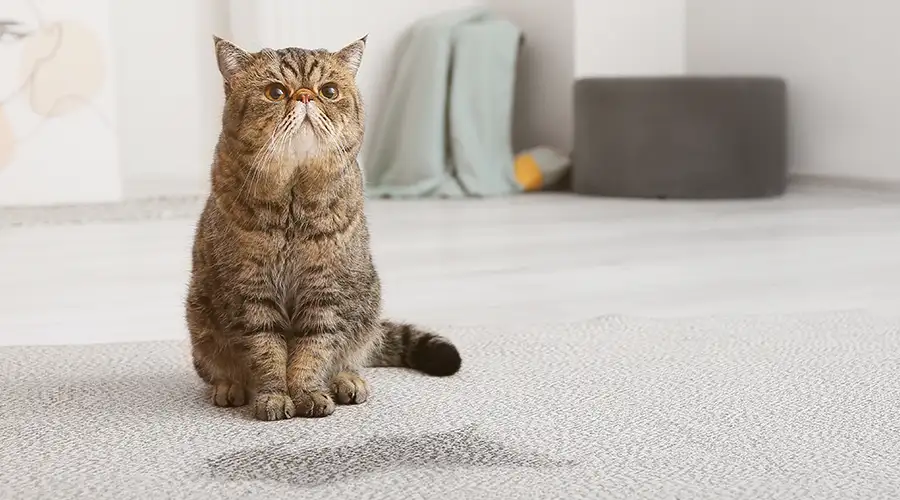
The Top 10 Best Cat Foods for Kidney Disease
Now that you have a better understanding of how kidney disease affects your cat and the role quality nutrition plays in his recovery, you’re ready to start shopping for cat food.
Remember, you don’t necessarily need to buy an expensive prescription diet as long as the cat food you choose meets your cat’s needs. It should be made with natural, whole-food ingredients including a moderate concentration of premium animal protein, high moisture content, plenty of healthy fats, and controlled levels of phosphorus and sodium. If you’re still not sure exactly what you’re looking for, try one of the recipes we’ve chosen:
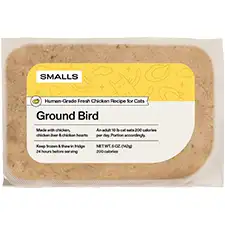 | Smalls Human-Grade Ground Bird Fresh Cat Food Delivery
| CHECK PRICE |
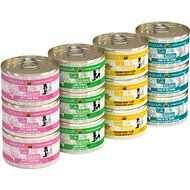 | Weruva Cats In The Kitchen Cuties Variety Pack
| CHECK PRICE |
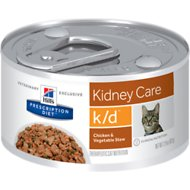 | Hill’s Prescription Diet K/D Kidney Care Canned Cat Food
| CHECK PRICE |
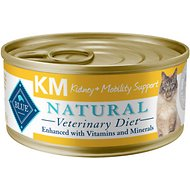 | Blue Buffalo Natural Veterinary Diet K+M Kidney
| CHECK PRICE |
 | Dave’s Pet Food Restricted Diet Protein & Phosphorus
| CHECK PRICE |
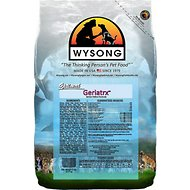 | Wysong Optimal Geriatryx Food
| CHECK PRICE |
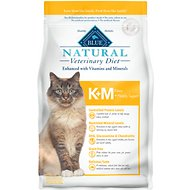 | Blue Buffalo Natural Veterinary Diet K+M Kidney
| CHECK PRICE |
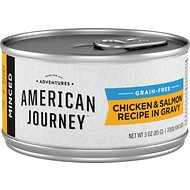 | American Journey Minced Chicken & Salmon Recipe Canned Cat Food
| CHECK PRICE |
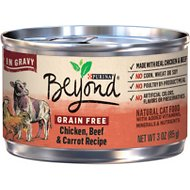 | Purina Beyond Grain-Free Chicken, Beef & Carrot Recipe Canned Food
| CHECK PRICE |
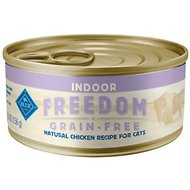 | Blue Buffalo Freedom Indoor Adult Chicken Recipe Canned Food
| CHECK PRICE |
Smalls Ground Bird Fresh Cat Food Delivery

Our Top Pick for the Best Cat Food for Kidney Disease Overall: If you want the best of the best for your cat, fresh food might be it. Smalls fresh pet food is made with only the highest quality natural ingredients and is completely free from artificial additives and preservatives. It contains real animal proteins like chicken and fish, and you can adjust the protein level according to your cat’s needs by working with a company representative. Compared to dry food, fresh food is much higher in moisture which is important for your cat’s kidney health. This food is also very high in nutrition to help your cat regain his health.
- Pros: Prepared fresh and delivered to your door, customizable nutrition, bird, fish, & beef recipes, very rich in moisture, fresh whole-food ingredients, no artificial additives
- Cons: Expensive to feed as a staple diet
Weruva Cats in the Kitchen Cuties Variety Pack Grain-Free Canned Food

Our Top Pick for the Best Affordable Cat Food for Kidney Disease: Veterinary diets are very expensive, and, in many cases, they aren’t even high-quality products. If you’re concerned about your cat’s renal health, but you don’t have a big budget to work with, consider Weruva Cats in the Kitchen wet cat food. As a wet food, this food is very high in moisture which is essential for kidney support, and it contains fresh, natural ingredients like real animal protein, digestible carbohydrates, and omega fatty acids. Because Weruva doesn’t use bone in their recipes, these formulas are also limited in terms of phosphorus content which makes it a low phosphorus cat food for kidney disease. Choose from a wide variety of formulas according to your cat’s preferences.
- Pros: Several flavors to choose from, real animal protein, controlled phosphorus levels, high moisture content, rich in omega fatty acids, complete and nutritionally balanced
- Cons: May be too high in protein for some cats, main source of fat is plant-based (sunflower seed oil)
Hill’s Prescription Diet k/d Kidney Care Canned Cat Food

Our Top Pick for the Most Popular Cat Food for Kidney Disease: If you’re looking for a prescription diet for kidney health, this Hill’s Prescription Diet k/d Kidney Care Canned Cat Food is a decent option. Though it does contain soy protein isolate, there are no harmful additives or low-quality grains as is the case for many prescription diets. This formula features a low-to-moderate concentration of protein and controlled levels of phosphorus and sodium for kidney support. It features chicken as the main ingredient with supplemental protein from pork and chicken livers as well as soy protein. It also contains beneficial supplements to ensure complete and balanced nutrition.
- Pros: Specifically designed for kidney support, low concentration of protein, controlled phosphorus and sodium levels, complete and nutritionally balanced
- Cons: Contains some soy ingredients, expensive to feed as a staple diet, unnamed fat source (fish oil)
Blue Buffalo Natural Veterinary Diet K+M Kidney + Mobility Support Canned Food

Our Top Pick for the Best Wet Cat Food for Kidney Disease: When it comes to the best cat food to prevent kidney disease or to manage it, moisture is essential which makes wet food a great option. This Blue Buffalo Natural Veterinary Diet K+M Kidney + Mobility Support Canned Food is a healthy choice because it is made from the finest natural ingredients and uniquely formulated for kidney support. This wet food features controlled levels of protein, phosphorus, and sodium with plenty of omega fatty acids and beneficial nutrients. This recipe is completely grain-free to reduce the risk of triggering food allergies and sensitivities, and it is complete and nutritionally balanced. It is only available with a prescription, but it is well worth it.
- Pros: Formulated for kidney support, all-natural ingredients, controlled protein and phosphorus levels, rich in omega-3 fatty acids, complete and nutritionally balanced, beneficial supplements
- Cons: Only available by prescription, expensive to feed as a staple diet, some cats are sensitive to beef
Dave’s Pet Food Restricted Diet Protein & Phosphorus Chicken Formula

Our Top Pick for the Best Grain-Free Cat Food for Kidney Disease: If you want your cat to have the benefit of low phosphorus cat food for kidney disease but you don’t want to deal with the hassle of refilling a prescription, Dave’s Pet Food Restricted Diet Protein & Phosphorus Chicken Formula is a great option. This recipe features controlled levels of protein, phosphorus, and sodium to provide optimal kidney support without the use of by-products and additives. This recipe contains fresh chicken as the first ingredient, and it is completely free from grains and gluten. It is highly digestible and contains beneficial supplements like vitamins and chelated minerals to ensure optimal nutrient absorption. All in all, it is a great choice for kidney support.
- Pros: Controlled levels of protein and phosphorus, real chicken as main ingredient, grain-free carbohydrates, beneficial supplements like chelated minerals, nutritionally balanced
- Cons: Somewhat expensive compared to other recipes, contains plant protein (pea protein)
Wysong Optimal Geriatryx Food

Our Top Pick for the Best Kidney Support Cat Food for Senior Cats: Older cats have a higher risk for developing kidney problems, so if you’re looking for the best cat food to prevent kidney disease, consider this Wysong Optimal Geriatryx Dry Food. This recipe is uniquely formulated for senior cats and features premium animal proteins, digestible carbohydrates, and fresh fruits and vegetables. It is rich in omega-3 fatty acids and is supplemented with enzymes and probiotics to ensure healthy digestion. This recipe features chicken and turkey as the primary proteins with whole-grain carbohydrates for maximum digestibility. All in all, this is a great recipe for any older cat, regardless of kidney disease.
- Pros: Formulated for senior cats, real animal proteins, whole-grain carbohydrates for digestibility. Rich in omega fatty acids, dried fruits and veggies, supplemented with enzymes and probiotics
- Cons: Not specifically designed for kidney support, expensive to feed as a staple diet
4 More Top-Rated Cat Foods for Kidney Disease
If the kidney-support cat foods reviewed above don’t seem like the right fit, there’s no need to worry – there are plenty of other options to choose from. Here are four more top-rated cat foods for kidney disease that we recommend:
Blue Buffalo Natural Veterinary Diet K+M Kidney + Mobility Support Dry Food

If you want to feed your cat a veterinary diet but prefer dry food to wet food, this Blue Buffalo Natural Veterinary Diet K+M Kidney + Mobility Support Dry Food is a great option. Formulated specifically for kidney support, this recipe features controlled levels of protein, phosphorus, and sodium but is rich in omega-3 fatty acids and essential nutrients. It is naturally grain-free for easy digestibility and supplemented with glucosamine and chondroitin for joint support. Plus, it is made only with wholesome, natural foods which puts it well above many prescription diets on the market.
- Pros: Wholesome natural foods, grain-free carbohydrates, controlled phosphorus and sodium, moderate protein, rich in omega-3s, nutritionally complete and balanced
- Cons: Expensive to feed as a staple diet, contains some plant protein (pea protein)
American Journey Minced Chicken & Salmon Recipe Canned Cat Food

Though not specifically designed for kidney support, this American Journey Minced Chicken & Salmon Recipe Canned Cat Food is an affordable option in cat food that offers moderate protein content and an ideal balance of omega fatty acids. It features fresh chicken as the primary ingredient with grain-free carbohydrates for digestibility. It is rich in natural sources of key nutrients such as fresh fruits and vegetables, plus it is supplemented with chelated minerals for optimal nutrient absorption. This is also a canned food recipe which means that it is higher in moisture content and, because it has a thick gravy, it will be highly palatable for cats who need to gain weight.
- Pros: Affordable recipe, high in moisture content, moderate protein, real food ingredients, fresh fruits and vegetables, blend of omega fatty acids, chelated mineral supplements
- Cons: Not specifically designed for kidney support, some cats are sensitive to chicken ingredients
Purina Beyond Grain-Free Chicken, Beef & Carrot Recipe Canned Food

Another affordable option in canned food for cats, this Purina Beyond Grain-Free Chicken, Beef & Carrot Recipe Canned Food could be a good fit for kidney support. It is high in moisture content with moderate protein levels and plenty of healthy fats for energy and coat support. This recipe features lean chicken as the primary source of protein with eggs, beef, and chicken liver for supplemental sources. It contains fresh fruits and vegetables as natural sources for key nutrients as well as beneficial supplements to ensure complete and balanced nutrition for your cat.
- Pros: Moderate protein levels, no grains or fillers, real chicken as main ingredient, supplemented for complete and balanced nutrition, chelated minerals
- Cons: Not specifically designed for kidney support, some cats may be sensitive to beef
Blue Buffalo Freedom Indoor Adult Chicken Recipe Canned Food

If you’re looking for a complete and balanced diet for your cat that will help him recover from kidney disease, this Blue Buffalo Freedom Indoor Adult Chicken Recipe Canned Food is a good option. It is made with only the freshest, natural ingredients including real animal protein, grain-free carbohydrates, and fresh fruits and vegetables. It is moisture-rich with moderate protein and plenty of omega fatty acids. It also contains chelated minerals and vitamin supplements to ensure complete and balanced nutrition. This recipe also contains supplemental fiber for digestion and hairball prevention.
- Pros: Formulated for indoor cats, moderate protein, plenty of omega fatty acids, chelated minerals, fresh fruits, and vegetables, rich in moisture and fiber
- Cons: Not specifically designed for kidney support, contains carrageenan, no probiotics
Frequently Asked Questions
What can I feed my cat with kidney disease?
Many veterinarians recommend prescription diets for cats with kidney disease, but you need to be careful about these. Prescription cat foods are expensive, and the price typically doesn’t reflect the quality of the ingredients. It may be better to do your own shopping for commercial cat food for kidney disease, finding a recipe that will support your cat’s needs for high moisture content, limited protein, and controlled levels of phosphorus and calcium.
How long does a cat live with kidney disease?
The answer to this question varies depending on several factors. Cats with acute kidney disease often make a full recovery with proper treatment, but chronic kidney disease can develop over the course of months or years, causing widespread damage that may take longer to repair. You also need to remember that kidney disease typically affects older cats, so your cat’s lifespan may already be limited by the time he develops the disease.
Can kidney disease in cats be reversed?
Acute kidney problems can often be reversed with proper treatment, but chronic kidney disease is more complicated. It is also important to remember that chronic kidney disease is frequently related to another underlying health problem like high blood pressure, thyroid disease, or cancer. When multiple diseases are implicated, it can make treatment more difficult and reduce the chances of recovery.
Can a cat recover from kidney disease?
The answer to this question is complicated because there are different forms of kidney disease. It is possible for a cat to recover from acute kidney disease, but the effects of chronic kidney disease may be more damaging. With proper treatment and dietary management, however, cats can live for years in spite of kidney disease. What you need to remember is that this disease commonly affects older cats, so if your cat is already 9 or 10 years old, his remaining lifespan may already be limited.
What is low phosphorus cat food for kidney disease?
When shopping for commercial cat food for kidney disease, you may come across low phosphorus cat food. This type of cat food is specifically designed for kidney support because high levels of phosphorus in a cat’s diet can speed up the rate of kidney damage. Low phosphorus cat food for kidney disease helps slow the damage and prevents secondary problems related to kidney disease.
Kidney Disease Cat Food – RECAP
It’s never easy to see your cat suffering, but it is your job as a cat owner to step up and do what it takes to see that he gets better. Kidney disease is a serious condition and leaving it untreated is likely to make your cat worse – much worse.
Fortunately, there are plenty of healthy cat food options that can benefit your cat’s kidney health. By following the advice we’ve provided here, you can take what you’ve learned and start shopping around for the best cat food to prevent kidney disease. If you’re not sure where to start, simply try one of the 10 top-rated recipes we’ve reviewed above!










